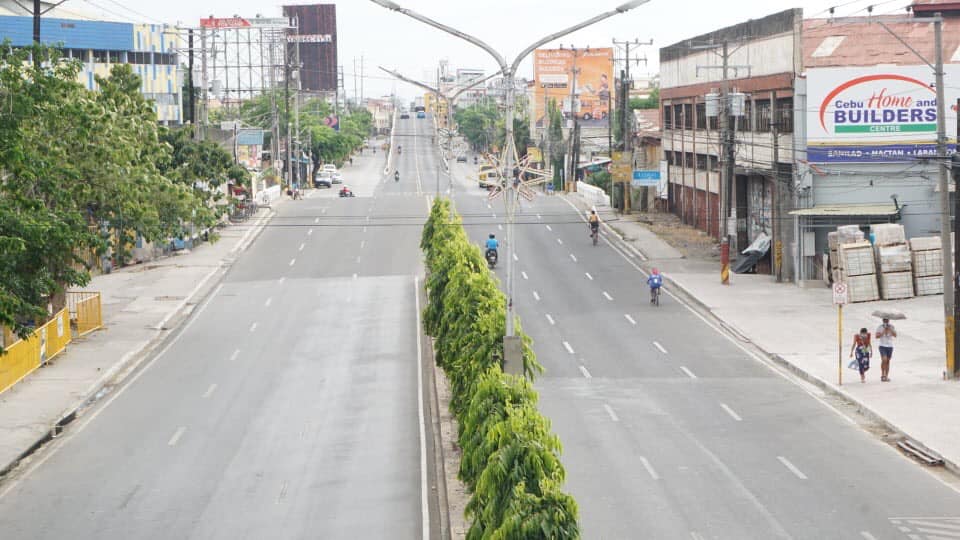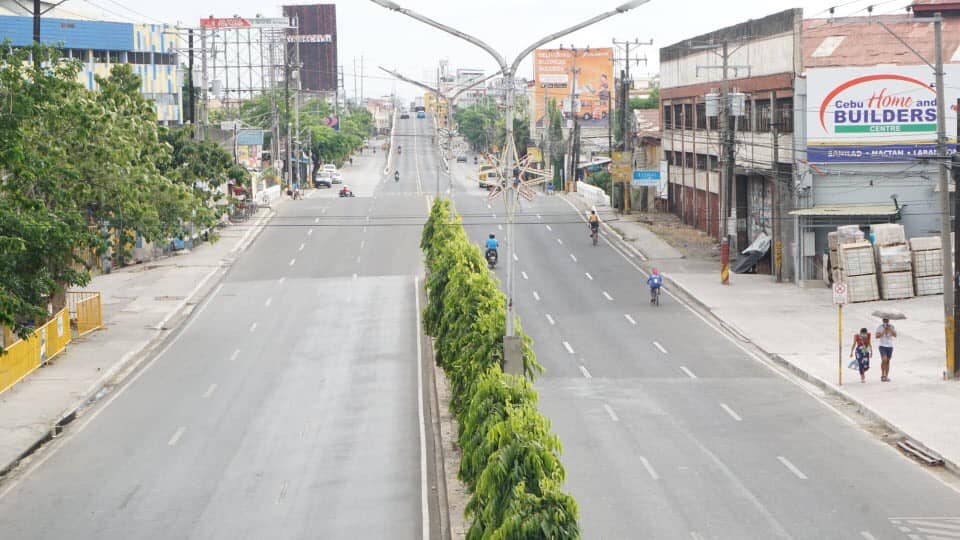
Streets along N. Bacalso Avenue in areas near Barangay Mambaling are nearly empty of vehicles as seen in this April 19, 2020 photo. |#CDNDigital | CDN Photo Gerard Vincent Francisco
(PART 1)
CEBU CITY, Philippines — Steam inhalation, locally known as tu-ob in Cebuano, has been a common home-made remedy among Cebuanos who suffer respiratory problems and infection.
Wrapping their heads in towels, and inhaling the steam coming from a freshly boiled water infused with ginger and several herbs have been the daily routine of Ben de la Rosa and his live-in partner, Nica Cadavero.
Both Ben and Nica are now staying in a designated isolation center in Barangay Luz, Cebu City after they tested positive of coronavirus disease 2019 (COVID-19) last April.
Ben and Nica, and their two infant children, reside in the village’s Sitio Zapatera. All four have been infected with COVID-19, which also downed 130 more in the densely populated sub-village that has over 9,000 residents.
But so far, Ben’s family has not experienced any symptoms of the disease such as fever, dry cough, and shortness of breath, and they are now racing their way to recovery.
“We are doing everything we can to keep our lives healthy. We not only do steam inhalation and drink vitamins given to us but we also exercise and do Zumba every morning,” Ben said in Cebuano over the phone.
Barangay Luz is just one of the heavily congested urban poor communities in Cebu City where COVID-19 was detected. The others are Barangays Mambaling (539), Labangon (125), and Suba (124). (These data are as of May 6.)
These figures, however, are a far cry from those reported during the outbreak’s first stages in Cebu City. Data compiled and computed by CDN Digital showed that the total number of COVID-19 cases in the city from March to April increased up to 30 times.
Local officials and health experts here attributed the figures’ dramatic rise to the massive testing implemented after the city government purchased a total of 30,000 test kits.
On one hand, mass testing was intended to determine the extent of the disease while on the other, it made way for a change in the outbreak’s dynamics — in terms of age distribution among patients, their health conditions, settings, and even socioeconomic background.
Cebu City has tested over 9,600 samples as of May 5, 2020.
Mass testing
Since March 29, there have been no documented COVID-19 cases reported in the provinces in Central Visayas except Cebu. Siquijor remains as the only island-province in the region free from any patient confirmed to have the disease.
As of May 5, Cebu province has a total of 1,566 coronavirus cases. These include inmates from three jailhouses, repatriated overseas workers, and healthcare workers who are also fighting the outbreak at the frontlines.
The figures comprised around 99.4 percent of the entire region’s total count. Both COVID-19 tallies of Negros Oriental and Bohol remained at four and one respectively.
1,388 of the 1,566 COVID-19 cases in Cebu came from the province’s capital, Cebu City, the largest city in Central Visayas in terms of population and economic activities, where over 1 million individuals reside and work.
The spike in the number of COVID-19 cases in Cebu City began between April 14 and April 15 when CHD finally rolled out the massive testing. As a result, double-digit and triple-digit reporting in the additional patients per day began.
Younger and Healthier Patients
Even before the massive testing commenced, Cebu City led in terms of areas in Central Visayas with the highest number of COVID-19 patients since March. However, most of those admitted back then happened to be adults, who were over 60 years old.
Now, the Department of Health in Central Visayas (DOH – 7) observed that majority of the new patients are getting younger, with several minors and even infants such as a 9-day-old baby are part of the city’s growing list of coronavirus cases.
Ben, a crew member of a popular restaurant chain, is 19 years old while his partner, Nica is only 18 years old. Their infant children were twins, both nine months old.
READ MORE: COVID-19 cases in Central Visayas reach 366, majority of patients now ‘younger’
Aside from age distribution, health experts also noted that most of the individuals discovered to be infected with COVID-19 are asymptomatic and healthier compared to those reported during the outbreak’s first stages in Cebu.
The death rate in Cebu City as of April 30 remained at 0.50 percent, which is way below the global average of 6.4 percent. According to DOH -7, low death rates are indicators of widened surveillance.
But even if they remained relatively healthy, Ben and Nica are not taking any chances with the infection they have. The couple is now looking forward to another round of swab tests to determine if their systems have been cleared with the virus.
“We’ve been staying in the isolation center for 9 days already. We really hope our laboratory results for the next round of tests will come out positive so we can resume our normal lives,” Ben added in Cebuano.
READ MORE: Cebu City breaches 400 in COVID-19 cases; majority asymptomatic
Closed Settings and Jam-Packed Communities
Cebu City also witnessed how the virus quickly spread from posh neighborhoods to crowded areas where physical distancing cannot be fully implemented, such as Sitio Zapatera in Barangay Luz.
Closed and densely populated settings, characteristics common of urban poor communities, contributed to the rising number of COVID-19 cases in Cebu City.
A lockdown was immediately implemented in parts where localized outbreaks are reported.
READ MORE: In Cebu City, around 89 percent of COVID-19 cases are from densely populated areas
The Cebu City Jail has a congestion rate of over 1,000 percent. The penal compound located in Barangay Kalunasan was designed to accommodate around 900 inmates only.
Data from the Bureau of Jail Management and Penology in Central Visayas (BJMP – 7) revealed, however, that it now houses over 6,600 detainees. Thus, it did not come as a surprise that when the virus reached there, it infected a total of 210 individuals, mostly prisoners, on April 30.
It increased to 332 on May 2 when further contact tracing and tests led authorities to discover 123 new patients confirmed to have the disease.
One of the facility’s newly inaugurated buildings was instantly converted into an isolation center where inmates confirmed to have COVID-19 will be staying until they recover from the disease.
The jail has been under lockdown since March 13. The city government also introduced new policies there as part of its efforts to contain the spread of the virus.
READ MORE: Mandatory swab testing for all inmates going in and out of Cebu City Jail
Meanwhile, Sitio Zapatera is home to more than 9,000 individuals. Due to its density, pathways leading to the sitio’s interior portions are often narrow, with houses built almost in an adjoining manner.
READ MORE: Mass testing continues for Sitio Zapatera, rest of Brgy. Luz to be tested
At least 136 of Barangay Luz’ 193 COVID-19 patients were discovered in Sitio Zapatera. The virus, however, has reached to nearby sitios particularly along Cabantan Street, and infecting 57 more others.
On May 5, however, Barangay Luz was overtaken by Barangay Mambaling in terms of the village with the highest number of COVID-19 Cases.
Similar to Sitio Zapatera, the epicenter of Mambaling’s outbreak was located in Alaska Mambaling, a heavily populated residential area that faces South Road Properties (SRP). Over 400 of the 539 COVID-19 patients in Barangay Mambaling are discovered in Alaska Mambaling.
READ MORE: Barangay Mambaling is Cebu City’s new COVID-19 hotspot
Barangays Labangon and Suba have also logged triple-digits in the number of COVID-19 cases in their respective territories.
Similar to Sitio Zapatera, Sitio Callejon in Barangay Labangon is also a heavily populated, urban poor community. This sub-village alone holds around 92 percent, or 115 out of 126, of Labangon’s total COVID-19 cases.
READ MORE: Labangon needs more space for COVID-19 patients
In Barangay Suba, on the other hand, most of those who were afflicted with the disease were connected to the Suba Fish Port, whose operations had been temporarily and indefinitely suspended.
Suba, a coastal village facing Mactan Channel, is home to one of Cebu City’s most important fish ports. From here, fresh catch of the day will be transported to other parts not only in the city but also for the entire island.
Of the 124 COVID-19 patients recorded in Barangay Suba, more than half of them reside in the streets of Abellana, General Gines, Belgium, Magsaysay, and Sto. Niño — all of which surrounds the Suba Fish Market.
READ MORE: Barangay Suba workers positive for COVID-19, chief calls for help
A total of 1, 215 COVID-19 patients are found in all areas in Cebu City where localized outbreaks are reported, which comprised around 88 percent of the city’s tally that has already reached 1, 388 as of May 6, 2020.
To be continued
